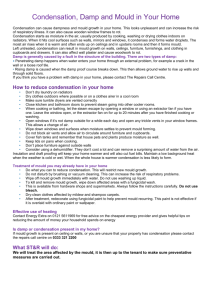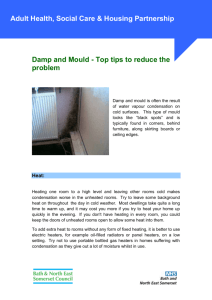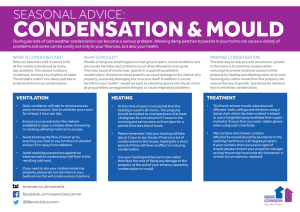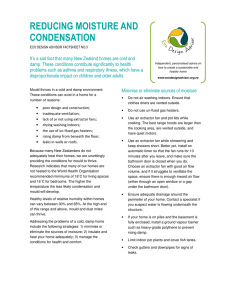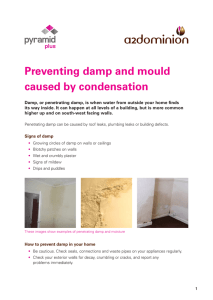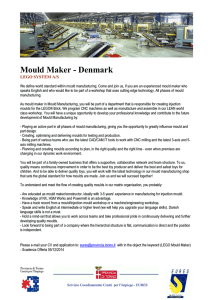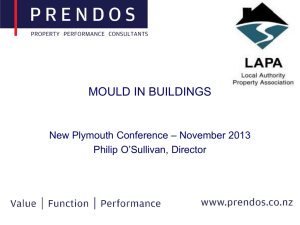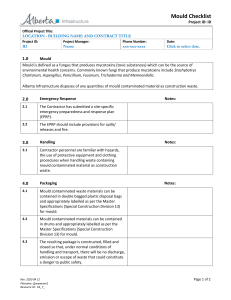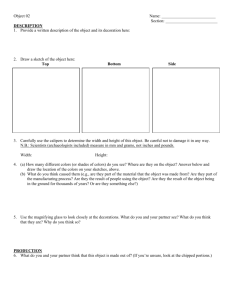Damp, Condensation and Mould - Plain English
advertisement
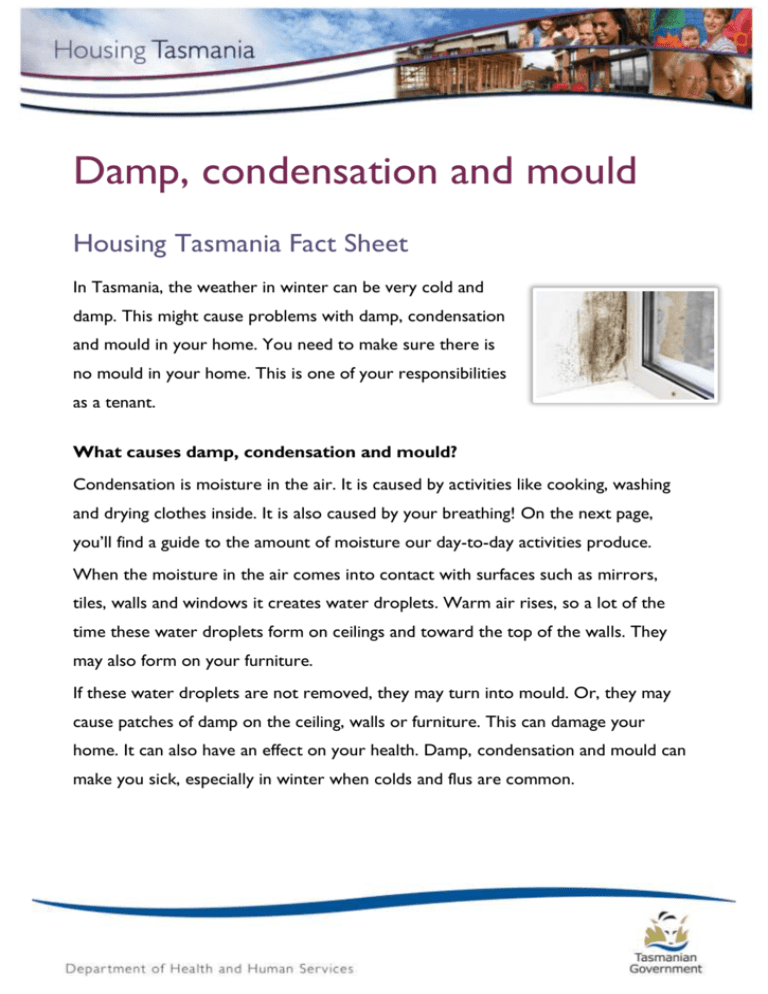
Damp, condensation and mould Housing Tasmania Fact Sheet In Tasmania, the weather in winter can be very cold and damp. This might cause problems with damp, condensation and mould in your home. You need to make sure there is no mould in your home. This is one of your responsibilities as a tenant. What causes damp, condensation and mould? Condensation is moisture in the air. It is caused by activities like cooking, washing and drying clothes inside. It is also caused by your breathing! On the next page, you’ll find a guide to the amount of moisture our day-to-day activities produce. When the moisture in the air comes into contact with surfaces such as mirrors, tiles, walls and windows it creates water droplets. Warm air rises, so a lot of the time these water droplets form on ceilings and toward the top of the walls. They may also form on your furniture. If these water droplets are not removed, they may turn into mould. Or, they may cause patches of damp on the ceiling, walls or furniture. This can damage your home. It can also have an effect on your health. Damp, condensation and mould can make you sick, especially in winter when colds and flus are common. A simple test for condensation If you want to work out if condensation is a problem in your home, here’s a simple test you can try: 1. Take a bottle of juice or other drink out of your fridge. 2. Wipe it clean with a dry cloth. 3. Put it in the room where you think there is a problem with condensation. 4. See if water droplets form on the outside of the bottle. If there are droplets it means that there is a lot of condensation. Page 2 What can you do about damp, condensation and mould? The best thing you can do is prevent the problem from happening. And the way to do this is to make sure your home is dry and well-aired. Here are some tips: open doors and windows when you can while you are home open windows or use an extractor fan when you are: cooking using the shower or bath using a clothes dryer - wipe condensation off ceilings, walls and windows or hang washing outside to dry keep your home warm when you can make sure clothes and shoes are dry before putting them away clean up leaks or spills straight away don’t use an un-flued gas heater that has a bottle – this type of heater creates a lot of moisture and is very unsafe to use allow some space between your furniture and the wall so that air can flow – this is very important with wardrobes try not to stack boxes or other items against outside walls, especially walls that don’t get a lot of sun. How can you get rid of mould? The longer you leave mould, the worse it becomes. It’s a good idea to get rid of it as soon as you can. Here are some inexpensive and practical products to use to kill mould: Tea tree oil – mix one teaspoon of oil into one cup of water in a spray bottle. Spray the mould but don’t rinse it off. You can store the tea tree oil mixture and use it anytime you notice mould in your home. Page 3 Grapefruit seed extract – mix 10 drops to one cup of water in a spray bottle. Spray the mould but don’t rinse it off. Like the tea tree oil, you can store this mixture and use it anytime you notice mould in your home. A good thing about this mixture is that it will not smell. White vinegar – put the vinegar into a spray bottle and spray it straight onto the problem areas. Don’t rinse it off. The smell will go away after a while. Household bleach – mix one cup of bleach with three cups of water and wipe onto the walls. Make sure you wear gloves and keep the windows open to air the fumes. Don’t scrub with bleach because you may damage the paint or the plaster. Another tip is to use absorbent beads in the room. These are sold in the supermarket and they usually come in a specially designed container. They soak up any extra moisture in the room. While they won’t get rid of the mould, they will help to prevent the problem in future. Janelle’s story Last winter, Janelle got sick with colds and flu quite a few times. She noticed that some mould was growing on the ceiling in her bedroom. She used tea tree oil to clean it. And she bought some absorbent beads from the supermarket. Janelle now always uses the extractor fan in the bathroom, and she leaves the windows open from time to time. This year, her health has improved. Page 4 Our contact details Housing Tasmania 1300 665 663 TTY users phone 133 677, then ask for 1300 13 55 13. Speak and Listen users phone 1300 555 727 then ask for 1300 13 55 13. Internet relay users connect to the NRS then ask for 1300 13 55 13. Department of Health and Human Services GPO Box 125 HOBART TAS 7001 www.dhhs.tas.gov.au/housing Page 5
